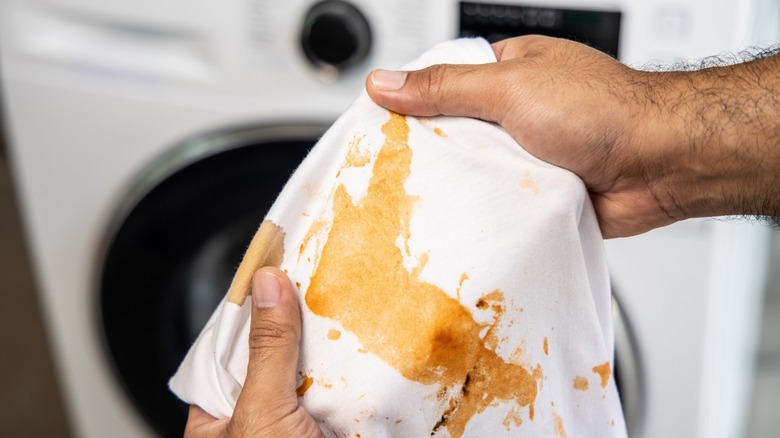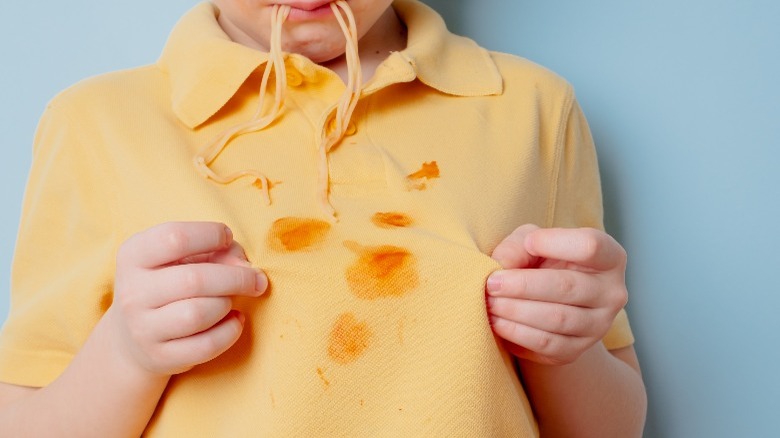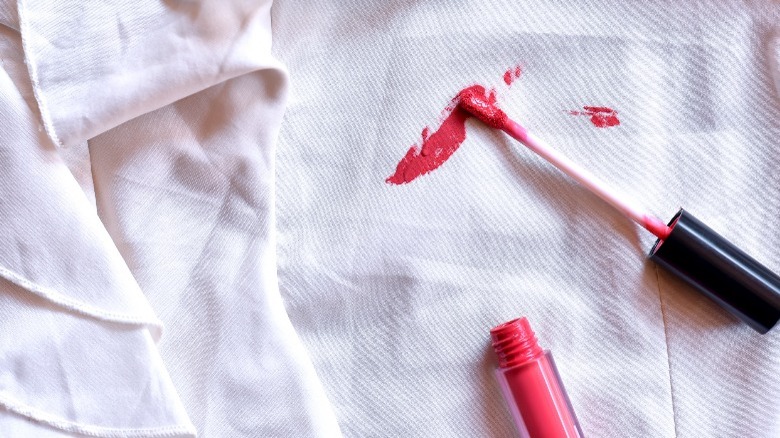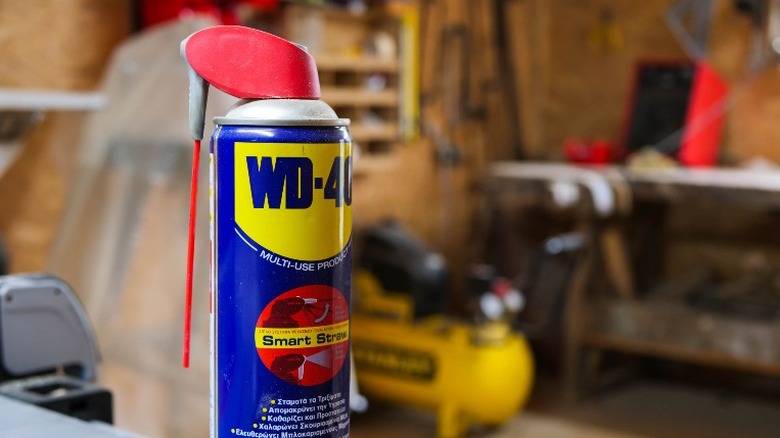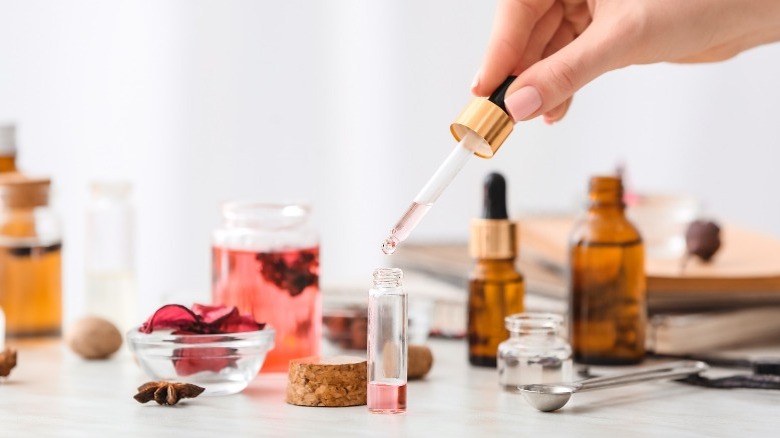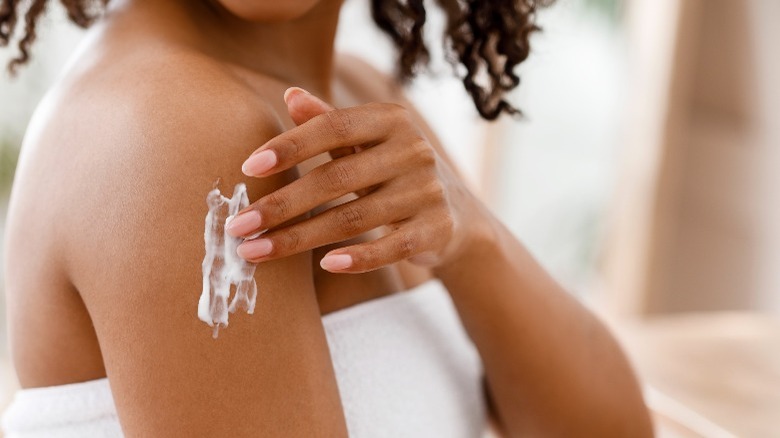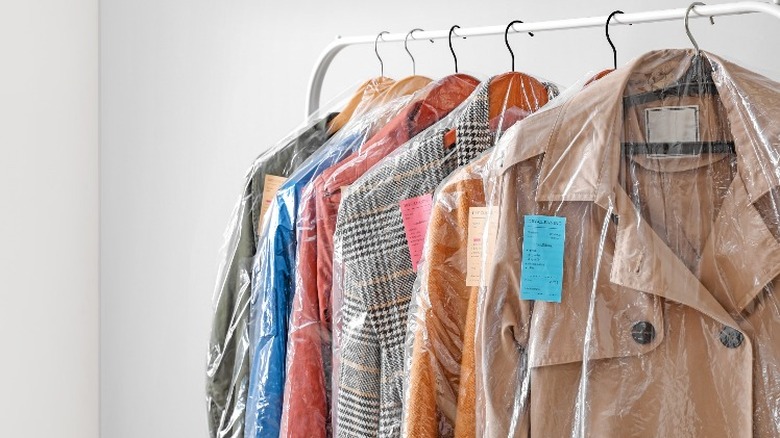The Best Way To Clean And Recognize Oil Based Stains
Oil-based stains can be some of the hardest stains to remove. Whether you have worn a favorite top while cooking and splashed it with oil, dropped a slice of pizza onto the sofa and ended up with a greasy stain, accidentally got WD40 on your best jeans, or tanning lotion on your favorite sarong, recognizing exactly what type of oil has caused the stain is an important factor in successfully getting rid of it. Each type of oil stain requires a different approach.
According to Grove Collaborative, allowing stains to set into your clothes and furnishings will do even more damage. Getting to the mark quickly and dealing with it when it's fresh will help to prevent it from doing lasting damage. The longer it sits, the more oil is being absorbed into your clothes, sofa, carpet, or soft furnishings.
To ensure a stain is removed effectively, you need to be sure it is oil-based before tackling it. The Spruce pointed out that oil-based stains may be easily missed as they don't show up in the same way as spilling something like mustard or ketchup, which would be a very obvious mark. Oil stains tend to leave a slightly dark area rather than a specific color.
Cooking oil and food grease
Identifying this type of oil stain should be fairly easy due to the smell; if it smells like the hamburger you had for lunch or the oil in your salad dressing, then there's your culprit! As with all oil stains, tackling it as soon as you notice it is the best way to make sure you can remove it fully. According to Apartment Therapy, you should first remove any excess food with a paper towel, then sprinkle the stain liberally with baking soda and leave it for at least 24 hours.
Next, vacuum the baking soda (which is helpful if you're dealing with oil stains on your sofa) or brush it away. Make up a mixture of equal parts vinegar and water and spray it directly on the stain, then launder as normal. Alternatively, scrub it gently with soap and a soft-bristle brush. If the stain remains, you can repeat these steps until it has been fully removed.
Foundation and makeup oils
This type of stain should be relatively straightforward to spot compared to some other oil-based stains, as it will have some color. Foundation is particularly oily and will leave a stain if it isn't dealt with right away.
The Strategist recommended using makeup remover, either in a wipe form or a liquid with cotton, wool, or a soft cloth. If you wear makeup, then chances are you will own makeup remover too. Make sure it is oil-free before you use it, or you will just make the problem worse. Wash your hands first to remove any makeup that is still on your fingers, then start by scraping off the excess and blotting the mark with the makeup remover. Soak a soft cloth with the remover and rub gently back and forth across the stain, and you should see it start to lift out. Once you have removed the majority of the stain, wash as normal, and that should take care of it.
Motor oil
This type of oil can vary in color, from light yellow to dark brown or black, and will be easy to identify by noticing its odor. It will often smell like gas and may be thick and sludgy. The best way to remove this type of oil stain from clothing, according to Tips Bulletin, is to cover the oil with some form of dry powder. Baking soda and talcum powder both work well.
Baking soda also has the added advantage of removing odors too, so this will help with the smell of the oil. Leave the powder to sit on the stain for a couple of hours to really soak up the oil, then brush off the remnants and see how much of the oil remains. Repeat the process if necessary. Finally, use some washing detergent and work it into to stain with a soft toothbrush and wash as normal.
Tanning oil
Again, as with most of these stains, the clue to figuring out what caused it is to pay attention to the scent. Perfume Shrine said that most tanning oils and sun creams have a creamy coconut or floral scent. So if you have recently been sunbathing in the garden or at the beach and the stain has a coconutty, floral smell, then the chances are that it is sunscreen or tanning oil.
Oureverydaylife pointed out two different methods to successfully remove tanning oil from clothing. The first method is to use a pre-wash stain remover. Use as per the instructions and then launder on the hottest possible wash according to the material and label. The other method is to use white vinegar. Pour a large amount into a bowl and soak the garment for at least an hour. Wash as per the label on the hottest temperature possible and air dry. For both of these methods, if the stain persists, then repeat the process until it is completely removed.
WD-40 and lubricating oils
This one is something of an anomaly. WD-40 can definitely stain your clothes if left on long enough to soak in, but it can also be used as a stain remover for certain types of stains. The Spruce explained that if used correctly it can remove things like chewing gum, candle wax, or melted crayons from fabric. It can also be used to break down old oil stains. Just remember to treat with a stain remover and wash immediately to stop the WD40 itself from staining your clothes.
If you've got some WD40 on your clothes by mistake and it's been left to dry, there are some things you can do to effectively remove it. Thriftyfun suggested using plenty of dish soap and hot water to break down the oil and remove it from your clothes. Another product that works well, according to Garagewire, is Swarfega hand cleaner, which should be applied to the oil mark and rubbed in. Afterward, just launder the clothes normally and that should fix the problem.
Essential oils
Essential oils are probably the easiest oil-based stains to identify due to their strong aroma and should be treated immediately for the best outcome. Depending on which essential oil you've been using, it will generally be fairly easy to pick up on and will leave a dark, discolored area.
Aromaeasy suggested using at least 70% isopropyl alcohol to break down and remove the stain. For a small stain, soak a cotton ball in the alcohol and apply it to the stain. For larger stains or on carpets, put the alcohol into a spray bottle. Saturate the area and leave it for at least an hour to allow the alcohol to penetrate the oil and break it down. Rinse with cold water and either allow to air dry for clothing or use a hairdryer on a cool setting for carpets.
If you have spilled essential oil onto a synthetic-based fabric, it will more than likely be irreparable. The fabric's appearance changes, and sometimes even its color is affected. When this happens, it cannot be reversed, and because of this, Aromaeasy adds, try to keep synthetic material separate from any essential oils to avoid permanent damage.
Moisturizer
This type of stain should be fairly easy to spot. It will have a creamy consistency but will still leave an oily stain behind if it isn't dealt with promptly. How 2 Remove Stains gave some good advice on this subject. They suggested using a blunt knife to remove as much of the product as possible and avoid pushing it further into the fabric.
The next step is to use an enzyme-based stain remover. Try to keep the fabric wet as moisturizers are water and oil-based, and keeping the fabric wet will allow the moisturizer to become diluted a little and help toward its removal. If you haven't got a stain remover, make a paste with washing powder and a little water and use a brush or your fingers to rub it into the stain, working from the outer edge to the center. Then rinse with hot water and allow it to air dry.
Oil-based stains on dry clean only clothing
If you managed to get an oil-based product on a dry clean only garment, try not to panic! If you can't rush straight out to the dry cleaners, there are things you can do at home. The Laundry Bag offered some great tips. They advised to spot-clean the stain and try to keep any water or stain removal products contained to just the affected area. Things like baking soda and citrus-based washing-up detergent won't harm your dry clean fabrics.
Place the clothing onto a towel. Sprinkle with the baking soda and leave to sit for an hour. Make a paste with white vinegar and liquid detergent and use a cotton swab to gently apply it to the stain. Rinse with cold water and allow the garment to air dry; you should then take it to a dry cleaner as soon as you can to make sure it is professionally finished. Hand sanitizer and alcohol are also great for spot treatments if you're in a pinch.
